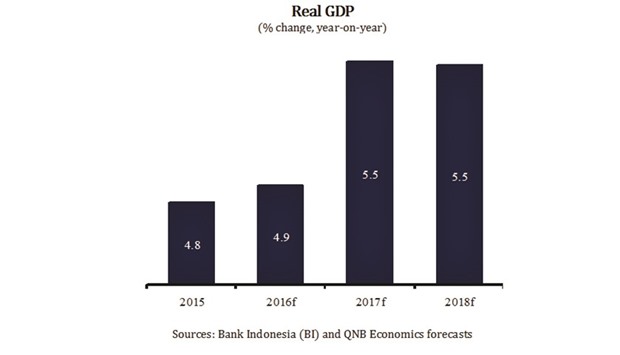QNB Group has published its Indonesia Economic Insight 2016 report, which examines recent developments and the outlook for the Indonesian economy as government reforms to encourage investment and a recovery in commodity prices should raise growth.
According to the report, real GDP growth rose to 5.0% year-on-year in H1 2016 from 4.8% in 2015, mainly as government efforts to push through an infrastructure programme drove investment.
Real GDP growth is expected to slow in the second half of 2016 as weak revenue and a ceiling on the budget deficit are likely to force the government to rein in spending.
“In 2017-18, we expect growth to pick up to 5.5% in both years on reforms to encourage investment, higher commodity prices and as interest rate cuts in 2016 feed through the economy to boost growth,” QNB said.
QNB said the current account deficit should widen slightly in 2017-18 on higher oil prices (Indonesia is a net oil importer), while prices of Indonesia’s other commodity exports are not expected to rise sufficiently to offset this.
Additionally, higher GDP growth should drive import demand while external demand for Indonesia’s exports continues to be constrained by the slowdown in China.
“We expect capital inflows to cover the current account deficit during 2016-18 as rising growth and progress on the infrastructure investment programme should sustain investor confidence in Indonesia,” QNB said.
QNB said lower than expected revenue is likely to push the fiscal deficit close to its legally binding limit of 3% of GDP in 2016, capping spending.
In 2017-18, revenue should recover due to a tax amnesty in 2017 and gradually rising commodity prices in both years.
The deficit is manageable as public debt is low (28.1% of GDP in 2016) and should stabilise as a share of GDP in 2017-18 owing to robust nominal GDP growth, QNB said.
Banking sector growth has slowed in 2016 while higher non-performing loans (NPLs) are pressuring profits. Growth in loans and deposits should pick up in 2017, but tighter liquidity could constrain lending in 2018.
“Banks’ profitability should remain high during 2017-18 as we expect asset quality to improve as growth picks up,” QNB said.

REFORM
